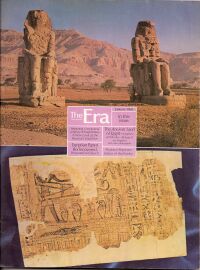
FAIR is a non-profit organization dedicated to providing well-documented answers to criticisms of the doctrine, practice, and history of The Church of Jesus Christ of Latter-day Saints.
No edit summary |
No edit summary |
||
| Line 9: | Line 9: | ||
{{:Question: What happened to the papyri after Joseph's death?}} | {{:Question: What happened to the papyri after Joseph's death?}} | ||
{{:Question: What do the Joseph Smith papyri fragments consist of?}} | {{:Question: What do the Joseph Smith papyri fragments consist of?}} | ||
== == | == == | ||
{{further information label}} | {{further information label}} | ||
| Answers portal |
| The Book of Abraham |
 |
|
FAQ:
Book of Abraham content: Production: |
|
"Translation and Historicity of the Book of Abraham," Gospel Topics on LDS.org:
The discovery of the papyrus fragments renewed debate about Joseph Smith’s translation. The fragments included one vignette, or illustration, that appears in the book of Abraham as facsimile 1. Long before the fragments were published by the Church, some Egyptologists had said that Joseph Smith’s explanations of the various elements of these facsimiles did not match their own interpretations of these drawings. Joseph Smith had published the facsimiles as freestanding drawings, cut off from the hieroglyphs or hieratic characters that originally surrounded the vignettes. The discovery of the fragments meant that readers could now see the hieroglyphs and characters immediately surrounding the vignette that became facsimile 1.
None of the characters on the papyrus fragments mentioned Abraham’s name or any of the events recorded in the book of Abraham. Mormon and non-Mormon Egyptologists agree that the characters on the fragments do not match the translation given in the book of Abraham, though there is not unanimity, even among non-Mormon scholars, about the proper interpretation of the vignettes on these fragments.[1]—(Click here to continue)

Believing that one of the papyrus rolls contained, "the writings of Abraham while he was in Egypt," and "purportedly written by his own hand, upon papyrus,"[2] Joseph commenced a translation. The Book of Abraham was the result of his work.
The translated text and facsimiles of three drawings were published in the early 1840s in serial fashion in the LDS newspaper Times and Seasons. The entire work was published in 1852 in England as part of The Pearl of Great Price, which was later canonized as part of LDS scripture.
Joseph Smith had in his possession three or four long scrolls, plus a hypocephalus (Facsimile 2). Of these original materials, only a handful of fragments were recovered at the Metropolitan Museum. The majority of the papyri remains lost, and has likely been destroyed. Critics who claim that we have all, or a majority, of the papyri possessed by Joseph Smith are simply mistaken.
The Egyptian characters on the recovered documents are a portion of the "Book of Breathings," an Egyptian religious text buried with mummies that instructed the dead on how to successfully reach the afterlife. This particular Book of Breathings was written for a deceased man named Hor, so it it usually called the Hor Book of Breathings.
Other than the vignette represented in Facsimile 1, the material on the papyri received by the Church, at least from a standard Egyptological point of view, does not include the actual text of the Book of Abraham. This was discussed in the Church publication, the New Era in January 1968.
After Joseph's death, the collection was eventually sold and split up. The original papyri were thought to have been completely destroyed in the Chicago fire of 1871. Fragments, however, including the illustration represented in Facsimile 1, were discovered in 1966 in the Metropolitan Museum of Art in New York City, who gave them to The Church of Jesus Christ of Latter-day Saints in November 1967.
There are eleven fragments of the original papyrus owned by Joseph Smith. The initial labels given the fragments came from Hugh Nibley's work.
The fragments that exist and their source are described in the table below, as are other materials of interest to students of the Book of Abraham:
| Fragments | Source | Comments |
|---|---|---|
|
|
|
|
|
|
|
|
|
|
|
|
|
|
|
So let’s start with the relationship of the Book of Abraham to the Joseph Smith Papyri. There are three different points of view here. One, that Joseph Smith translated the Book of Abraham from the papyri that we have. Almost no one really believes this. But to hear the critics tell it this is the official position of the church. It’s not. Nor do most members of the church subscribe to this so far as I can tell. So, it’s a strawman. The second one is that Joseph Smith translated the Book of Abraham from papyri that we do not currently have and this is the position that most accords with the historical evidence. And the third one is that Joseph Smith received the Book of Abraham strictly by revelation and it did not come from the papyri at all. This position seems to be popular among Latter-day Saints but seems to have no historical evidence to support it.

FAIR is a non-profit organization dedicated to providing well-documented answers to criticisms of the doctrine, practice, and history of The Church of Jesus Christ of Latter-day Saints.
We are a volunteer organization. We invite you to give back.
Donate Now